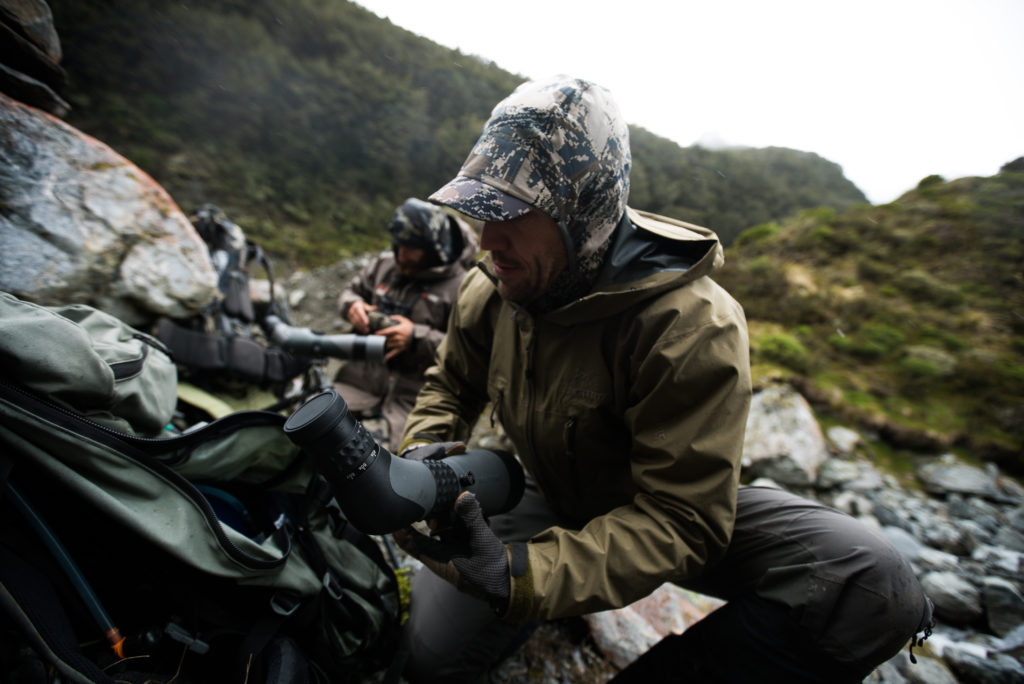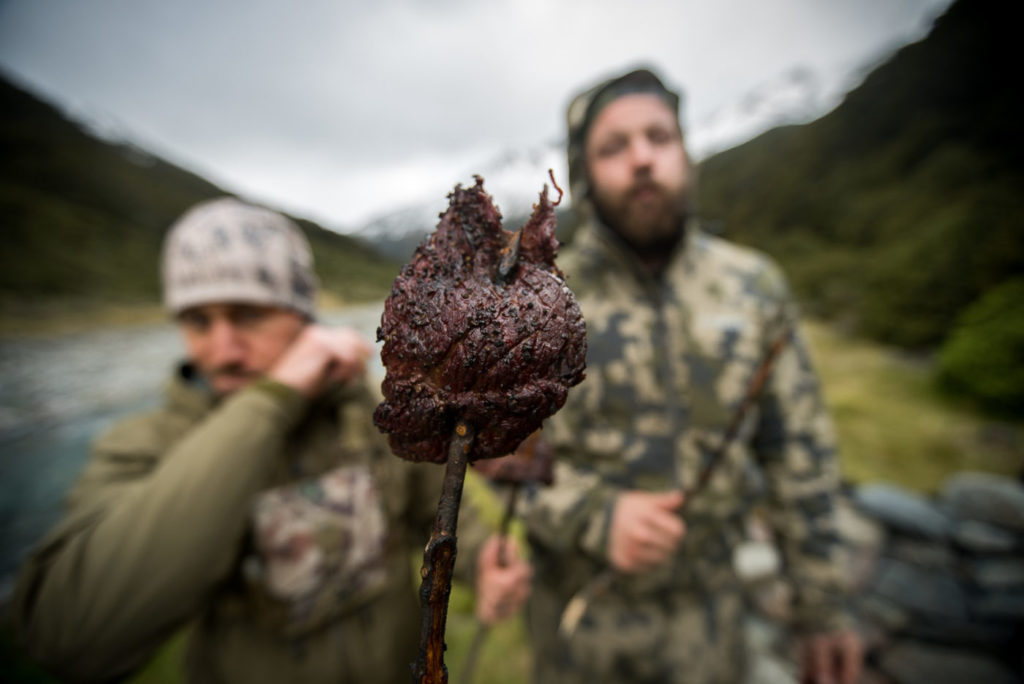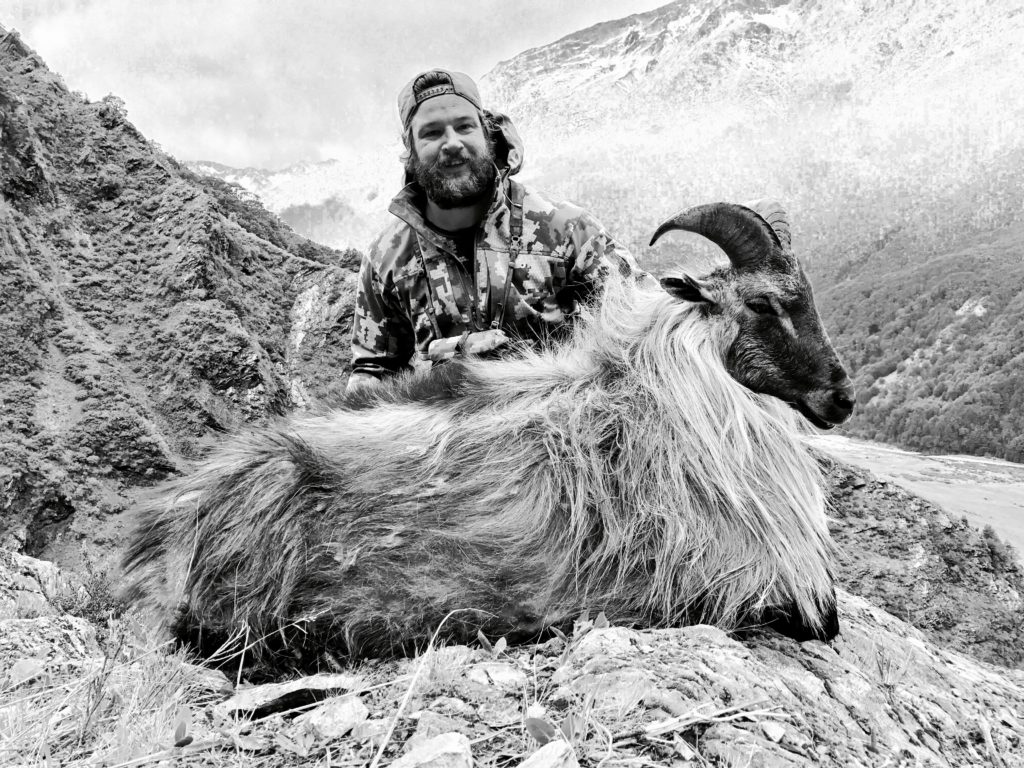Feature Image Photo Credit Cedar & Sagebrush
“Hey Tim, how much do you think it rained today?”
As I looked at Tim, he thought for a moment and then in typical dry Kiwi fashion answered:
“Oh not much eh…only about 150 millimeters…”
Having been raised on the coast of northern British Columbia for my entire life, I knew something was wrong with this statement. It was only day one, and I knew I was in for the adventure of a lifetime.
Team morale was high; our energy could be felt across the entire stormy island. Three hardcore British Columbian hunters, eager to hunt their top choice of international game for the first time, accompanied by two Kiwi guides, masters of their trades. A little Nissan built for swimming transported us deep within the southern alps of New Zealand. We crawled for miles across creeks and rivers, in large, stone-covered valley bottoms. After reaching our trailhead, we geared up for a brisk walk in the weather.
The hike was fine through the beech wood, until we reached a new range of mountains. Once we hit the valley floor, Mother Nature hit us with what we thought was all she had, but we later learned that for the locals it was just another rainy day. We were greeted with gale-force winds, stripping hats from our heads, while hobbit-like Kiwis were forced to take a knee rather than get blown over. The icy rain would have likely peeled the skin from my face if it wasn’t for a true BC bush beard. The only thing that ended up saving the rest of our flesh was that the ice finally turned to snow. We passed locals turning back to seek shelter in a nearby hut, but our band of misfits pushed on.
Before my 20-plus hour flight, I’d woken up as sick as I could be; a common misfortune that seems to plague my existence. The hike to base camp didn’t help my fever, so when the boys decided to head out and find some tahr that evening, we decided it would be best if I got my beauty sleep; that way we could hunt hard the following day. Several hours later the gang returned saying they’d spotted some young bulls. I was green with envy due to the fact that I’d never seen one on the hoof.

When morning came around, the weather had not let up one bit. We waited it out, sipping various hot beverages and resting after the Trans-Pacific journey and previous day’s hike. As the morning transitioned into afternoon, the weather started to break and we made a game plan to check out a new creek in a different valley. As I sipped my coffee, I rested my voice that would barely let out a squeak. I decided I would hang back and check out the small bulls our group spotted the night before but only if the weather truly let up. My new friend Tim “The Butcher” Butcher said he would hang back with me in case luck, and the weather, was on our side.
As the weather started showing signs of breaking for good, I strung my bow, installed my broad heads, and we were off. Instead of exposing ourselves on the riverbed, we decided to sneak back to the crags through the beech wood. It wasn’t long before we spotted tahr.
Halfway up the steep face of a typically foreboding New Zealand peak was a mob of three young bulls and an old nanny. I wasted no time busting out the spotter and began settling in. Although these animals weren’t impressive, or “proper,” bulls, I was still amazed to watch them for the first time. The young bulls played and danced, their thin manes fluttering like tiny sails in the wind.
After inspecting the nearby bluffs, we decided to poke down the valley a little farther, to where JP had seen two dandy bulls a few weeks back. We scanned over a steep, gnarly face with cascading waterfall after waterfall. After moving positions I managed to spot something with the naked eye that didn’t look right — I pointed it out to Tim and he said he also agreed that it was a tahr. One quick look through the binos and I knew he had to be a shooter, although I could not judge one of these critters to save my life. I was quickly reassured when The Butcher said, “Yip, a proper bull!”
We quickly assessed our options. Strong, terrible winds: check. Vertical walls of icy vegetation: check. Snow squalls: check. We planned a route and decided on the best of the mess. It was clear that we could not climb the face without both our hands, and retrieval was going to be gruesome at best. It was day one, and we had unlimited tags on this species. I decided to take a true monarch of the mountain now, and I could stalk another one with the bow on another day in more suitable conditions.
I settled in behind Tim’s rifle, and he gave me a range at 280 meters. A thought came to my head that I hadn’t shot a rifle in some time, so I decided to get rock-steady and dry fire a handful of times. Everything felt as good as could be.
The bull was in a rotten spot, so we tried to wait for him to move somewhere better for retrieval, but with the weather progressively getting worse, we decided I should shoot for his shoulder on a quartering-to shot to try to anchor him in place.
The wind was pounding at this point, so I led him almost a foot. The safety was off and the rifle was hot; my anticipation grew with every second. Tim lined up the spotter and gave me the go-ahead.
The trigger was light and the rifle neither budged, nor barked, due to the suppresser tipping the 270. I watched the tahr buckle over and run towards the cascading waterfalls. Tim confirmed the hit, and the tahr rolled over and came to a stop. We shook hands and congratulated each other, but we both knew that that had been the easy part.
We packed up our gear and headed up a small creek towards the base of the face where the bull was hung up. Once we were below, we emptied our packs except for our knives and camera gear. We had 100′ of rope on this trip but we’d sent it off with the other guys, since we knew this country could get hairy real quick and they were heading into entirely new terrain, even for our guides.
The initial climb wasn’t so bad; I only say that because you were able to use both hands while climbing up a steep scrub face. I figured it would feel like home when I reached the bare rock bluffs, but I was wrong. The rocks in NZ are very slippery; not grippy like the granite we have back in BC. Sure enough, this proved to be difficult climbing. After a couple rock-skips over waterfalls and some more crawling up faces, we arrived to my tahr.
We dropped our packs and just sat down beside the bull. I was overwhelmed with emotion as I stared at this bizarre creature up close for the first time. I think it was a few moments before I even grasped his horns and rubbed my hands through his thick mane. A proper bull indeed.
It was a little smaller than a mountain goat, yet every bit as majestic. Its hair was a much lighter colour than I expected, and was striped along the dorsal. The webs of my fingers caked with grease as I ran my hands down his back. His face had harsh character; it reminded me of an old, dusty book sitting at the back of the shelf. His ear was split from fighting. His horns were impressively long and heavy, with prominent ridges up the front, and they swept back, and curved towards each other at the busted tips. Nearly 13″ of horn and nine rings stacked above each other proved how old this bull was. The bases were as thick as he was old. Truly a mountain bad ass.
The weather decided to break in time for pictures. We rolled him over to the edge of the cliff he was on, and I carefully crawled behind him. We took a bunch of photos, but before we could finish the snow started to come. We put away the camera gear and unsheathed the knives. I skinned him for a pedestal mount, and Tim started deboning the quarters. After I popped the backstraps, The Butcher gutted him and pulled the heart. We let the meat sit on rocks to cool for a minute, and then we loaded our packs.
We decided we would try climbing down another way. We would cross another waterfall and then try and climb up higher and access a spine of beech trees that we hoped would make for an easier hike out. After two different attempts, we came to the conclusion this simply wouldn’t work. I took a good fall and was hung up upside down, with my leg caught in some roots. Tim helped me to my feet, and we decided to descend the way we had come up. It was pretty hairy, but Tim found us some good routes, and at the end of the day we both made it out alive.
Finally reunited with the gear we dumped out earlier we loaded our packs once again. The walk back to the hut across the valley bottom wasn’t so bad, even though my legs were dead; it was relatively flat and uneventful. Lower on the valley floor, the snow turned to rain, and the strong winds pushed against us with a cold bite.

Once we arrived to the hut, we stripped down out of our wet gear and took our boots off. We got into some warm clothes and started prepping the backstrap for dinner. Once the rest of our group arrived back at camp, we cracked the whiskey. The boys fed on backstrap and heart mixed with instant gravy. That night in camp was irreplaceable; laughs were shared by all, as were even more lies. It was the type of successful hunt celebration that we all dream of and remember fondly for the rest of our lives.


